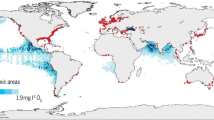You have full access to this open access chapter, Download chapter PDF
Similar content being viewed by others
Correction to: Chapter 13 in: T. Kuwae, M. Hori (eds.), Blue Carbon in Shallow Coastal Ecosystems, https://doi.org/10.1007/978-981-13-1295-3_13
This chapter was inadvertently published with errors. The following corrections have been made after original publication.
Page 347 Abstract lines 3–6:
“The capability of net uptake of atmospheric CO2 and soil organic carbon accumulation in global shallow coastal ecosystems are estimated to be about 1670 Tg C year–1 and about 200 Tg C year–1, respectively, with considerably large variabilities and uncertainties.”
has been revised to
“The capability of net uptake of atmospheric CO2 and soil organic carbon accumulation in global shallow coastal ecosystems are estimated to be about 1070 Tg C year–1 and about 140 Tg C year–1, respectively, with considerably large variabilities and uncertainties.”
P350 Table 13.1
Tidal marshes: CO2 exchange, mean –661 Tg C year–1, min –2271 Tg C year–1, max 174 Tg C year–1; Soil carbon accumulation rate, mean 77 Tg C year–1, max 865 Tg C year–1; Global area, median 0.51 million km2, max 0.50 million km2
Total: CO2 exchange, mean –1666 Tg C year–1, min –8438 Tg C year–1, max 6302 Tg C year–1; Soil carbon accumulation rate, mean 205 Tg C year–1, max 1017 Tg C year–1
has been revised to
Tidal marshes: CO2 exchange, mean –66 Tg C year–1, min –1817 Tg C year–1, max 139 Tg C year–1; Soil carbon accumulation rate, mean 8 Tg C year–1, max 692 Tg C year–1; Global area, median 0.05 million km2, max 0.40 million km2
Total: CO2 exchange, mean –1071 Tg C year–1, min –7984 Tg C year–1, max 6268 Tg C year–1; Soil carbon accumulation rate, mean 136 Tg C year–1, max 844 Tg C year–1
P351 lines 1 to 10:
The global estimate of the soil organic carbon accumulation rate in SCEs ranged from 20 to 1,017 Tg C year–1, with a mean value of 205 Tg C year–1, which is comparable to previous reports (Nellemann et al. 2009; Pendleton et al. 2012). Estuaries (mean, 81 Tg C year–1) were major contributors to the total accumulation rate in SCEs, as reported previously (Nellemann et al. 2009).
To the best of our knowledge, this work provides the first global estimate of CO2 exchange rates in SCEs. The estimated rates ranged from –8438 to 6302 Tg C year–1, with a mean of –1666 Tg C year–1 (negative value: net uptake of atmospheric CO2).
has been revised to
The global estimate of the soil organic carbon accumulation rate in SCEs ranged from 20 to 844 Tg C year–1, with a mean value of 136 Tg C year–1, which is comparable to previous reports (Nellemann et al. 2009; Pendleton et al. 2012). Estuaries (mean, 81 Tg C year–1) were major contributors to the total accumulation rate in SCEs, as reported previously (Nellemann et al. 2009).
To the best of our knowledge, this work provides the first global estimate of CO2 exchange rates in SCEs. The estimated rates ranged from –7984 to 6268 Tg C year–1, with a mean of –1071 Tg C year–1 (negative value: net uptake of atmospheric CO2).
P351 lines 17–21:
Another explanation is that the estimate of major contributors to the large exchange rate, namely, mangroves (mean, –336 Tg C year–1) and tidal marshes (mean, –661Tg C year–1), have already been implicitly included in the global estimate of the terrestrial CO2 exchange rate (–2,300 ± 700 Tg C year–1).
has been revised to
Another explanation is that the estimate of major contributors to the large exchange rate, namely, mangroves (mean, –336 Tg C year–1) and tidal marshes (mean, –66 Tg C year–1), have already been implicitly included in the global estimate of the terrestrial CO2 exchange rate (–2,300 ± 700 Tg C year–1).
Fig. 13.1 has been revised as below
Author information
Authors and Affiliations
Corresponding author
Editor information
Editors and Affiliations
Rights and permissions
Copyright information
© 2019 Springer Nature Singapore Pte Ltd.
About this chapter
Cite this chapter
Kuwae, T., Hori, M. (2019). Correction to: The Future of Blue Carbon: Addressing Global Environmental Issues. In: Kuwae, T., Hori, M. (eds) Blue Carbon in Shallow Coastal Ecosystems. Springer, Singapore. https://doi.org/10.1007/978-981-13-1295-3_14
Download citation
DOI: https://doi.org/10.1007/978-981-13-1295-3_14
Published:
Publisher Name: Springer, Singapore
Print ISBN: 978-981-13-1294-6
Online ISBN: 978-981-13-1295-3
eBook Packages: Earth and Environmental ScienceEarth and Environmental Science (R0)





